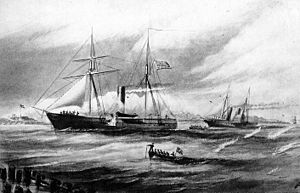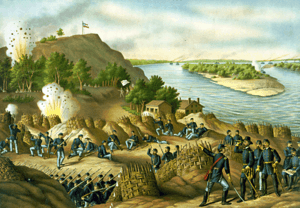Anaconda Plan facts for kids
The Anaconda Plan was a smart strategy used by the Union Army at the start of the American Civil War. It was suggested by Union General-in-Chief Winfield Scott. The plan had two main parts: first, a Union blockade to stop ships from entering or leaving Southern ports. Second, Union forces would move down the Mississippi River to cut the South in half. People joked that the plan was like an anaconda snake slowly squeezing its victim, which is how it got its famous name.
General Scott believed this plan would help the Union win with less fighting. He thought the blockade would weaken the Confederacy, and controlling the Mississippi River would split their forces.
Contents
How the Anaconda Plan Started
The Anaconda Plan grew from ideas already being used. On April 19, 1861, soon after the war began, President Abraham Lincoln announced a blockade of all Southern ports. This blockade was already happening, separate from Scott's full plan.
General Scott's plan had two main parts. First, all ports in the Southern states would be tightly blockaded. Second, a large group of about 80,000 soldiers would use the Mississippi River as a path to go through the Confederacy. A smaller group of soldiers, carried by boats and supported by gunboats, would quickly capture Confederate spots along the river. A larger army would follow to secure these victories. The main goal was to capture the forts near New Orleans. Once these forts fell, the Union would control the entire Mississippi River, cutting the Confederacy in two.
Some generals, like George B. McClellan, had different ideas. McClellan wanted to march directly on Richmond, the Confederate capital. But General Scott thought McClellan's ideas were too risky and would cause too much damage. Scott believed his plan, which involved surrounding the South by sea and along the Mississippi, was better.
General Scott was old and sick, so he retired later that year. George B. McClellan then became the new General-in-Chief.
Controlling the Mississippi River
Even though General Scott had a clear plan for the Mississippi River, it wasn't always the main focus for some Union generals. However, the Navy Department really wanted to open up the Mississippi.
The Navy decided to capture New Orleans, a very important city, by attacking it from the Gulf of Mexico. Captain (later Admiral) David Glasgow Farragut led this mission. On April 24, 1862, he sailed his fleet past the forts defending New Orleans. The city was forced to surrender. After that, Farragut's ships went up the river, taking Baton Rouge and Natchez.
But their easy victories stopped at Vicksburg, Mississippi. The Confederate positions there were on high cliffs, making them impossible for naval guns to hit.
After the Union captured Island No. 10 and Memphis, Tennessee, the Mississippi River was open to Union control all the way down to Vicksburg. This meant Vicksburg was the only place on the river still held by the Confederates.
The Army, under generals like Henry Halleck and later Ulysses S. Grant, eventually focused on Vicksburg. The Confederates had strongly fortified Vicksburg and Port Hudson to the south. This 130-mile stretch of the river was the last connection between the eastern and western parts of the Confederacy.
The campaign for Vicksburg became a long siege. On July 4, 1863, the Confederate forces at Vicksburg surrendered. Soon after, on July 9, 1863, the Confederate garrison at Port Hudson also surrendered. With these victories, President Abraham Lincoln famously said, "The Father of Waters again goes unvexed to the sea." This meant the Union controlled the entire Mississippi River, and the Confederacy was truly cut in two.

General Scott's Anaconda Plan heavily relied on the naval blockade. He believed it would "envelop the insurgent States and bring them to terms with less bloodshed." The blockade aimed to stop the Confederacy from getting supplies and selling its goods, like cotton, to other countries.
To make the blockade work, the Union Navy needed places to refuel their steamships. Since all suitable harbors in the South were controlled by the Confederacy, the Union had to capture some. This meant the blockade wasn't just about ships at sea; it also involved taking enemy territory.
Key places captured to help the blockade included forts near Cape Hatteras in North Carolina, and Port Royal, South Carolina. Port Royal became a major base for blocking Savannah and Charleston. Later, Fernandina, Florida, was also taken.
The blockade of Wilmington and Charleston was very important. These were major ports for blockade runners – fast, small ships that tried to sneak past the Union Navy. The Union tried to block Charleston's harbor by sinking ships, but it didn't work well. Union ships also helped in ground attacks on forts near Charleston.
The Confederates tried to break the blockade using new weapons like mines, armored ships, and even early submarines and torpedo boats. Despite these efforts, the Union blockade became stronger over time. Wilmington remained a key port for the Confederacy until Fort Fisher, which protected its entrance, was captured by Union forces in January 1865.
The blockade of Gulf Coast ports like Mobile and Galveston was less important. These ports were farther away from the main blockade-running routes. After New Orleans fell to the Union in April 1862, Mobile became the last major problem for the Gulf blockade. In August 1864, Admiral Farragut led a famous attack on Mobile Bay, saying, "Damn the torpedoes, full speed ahead!" He captured the forts, making Mobile useless as a port for the Confederacy.
Did the Plan Work?
Historians still debate how important the Anaconda Plan was. It certainly wasn't "bloodless" as General Scott hoped, as the war became very violent.
Most historians agree that controlling the Mississippi River was extremely important. The Union's victories in the West, especially the capture of Vicksburg, were crucial. This part of the Anaconda Plan is seen as very successful.
However, the effectiveness of the Union blockade is still discussed. Some argue it wasn't very effective because many blockade runners successfully got through. They point out that over three-quarters of attempts to sneak past the blockade were successful. Also, they say the South's supply problems were more due to their poor railroads than the blockade itself.
Others argue that the blockade was very important. They say that even though many small ships got through, the blockade stopped large cargo ships. This caused Southern exports, especially cotton, to drop by 95%. This severely damaged the Confederate economy and made it hard for them to get money and supplies. The blockade also made coastal trade difficult, putting more strain on the already weak Southern railroads. They believe the blockade slowly strangled the Confederacy, weakening its armies and economy until it could no longer fight. The fall of Wilmington, the last major blockade-running port, happened just before the Confederacy collapsed, suggesting the blockade played a big role.
However, the blockade was less successful at stopping weapons and money from being smuggled into Southern ports by British-built blockade runners. It is estimated that the Confederates received thousands of tons of gunpowder, half a million rifles, and hundreds of cannons from these runners. Some historians believe this extended the war by two years.
See also
 In Spanish: Plan Anaconda para niños
In Spanish: Plan Anaconda para niños


